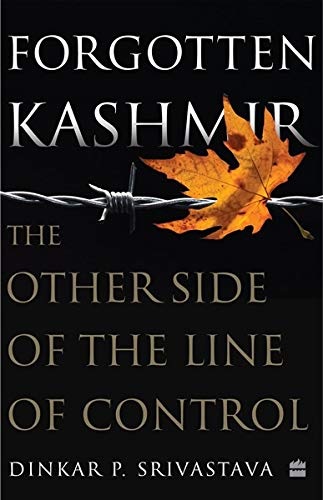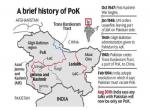“Forgotten Kashmir” while touching upon Pakistan’s invasion of Kashmir and the issue of self determination in the context of the people of Kashmir is mainly focussed on Pakistan Occupied Kashmir (PoK) inclusive of both so called Azad Kashmir and Gilgit Baltistan. These illegally occupied areas by Pakistan tend to be only tangentially treated by most books on Kashmir and have generally eluded attention. The book, therefore, fills an important gap. This is all the more so as it painstakingly details the manner in which so called Azad Kashmir and Gilgit Baltistan have been reduced to being Pakistani colonies with their people being deprived of their fundamental human rights and being forced to live under the jackboot of the Pakistani state. The author, therefore, deserves to be commended for penning this book and all the more so as he has relied heavily on Pakistani sources like PoK Justices Saraf and Gillani, Qudrat Ullah Shahab, Major General Akbar Khan, Sardar Ibrahim Khan etc. It would not be out of place to mention that the author is particularly well placed to deal with Kashmir as he was India’s points man on the issue in the 90’s when there was a campaign to mount a resolution in the matter against India by Pakistan. Much of the credit for our being able to successfully counter this must go to him.
The book comprehensively debunks Pakistan’s contention that what transpired in Kashmir in 1947 was an indigenous uprising and conclusively proves that it was in fact a tribal invasion planned and supported with men and materials by Pakistan and later led by Col Akbar Khan. The decision in this regard was taken at a meeting chaired by the Pakistan PM in which not a single Kashmiri was present. The Muslim Conference had no hold in Kashmir and its senior leadership had no idea of the decision to establish a provisional government. In fact, Sardar Mohammad Ibrahim who was appointed as its President late in October was apprised of the same late at night by Col Akbar Khan’s wife and the Commissioner Rawalpindi. Pakistan’s scant regard for the wishes of the people of Kashmir is reflected in Jinnah’s response to a query in this regard when he stated “Let the people go to hell.”
Pakistan’s entrée into Kashmir proper was by a thinly veiled invasion under the garb of a tribal invasion that into Gilgit Baltistan was by a blatant coup de tat treacherously executed by Major Brown who headed the Gilgit scouts against the Kashmir Maharaja’s governor at Gilgit on 31st October 1947 in reaction to the Maharaja’s accession to India. The governor was placed under arrest and Gilgit acceded to Pakistan though the locals wanted independence. Major Brown acting in cahoots with Pakistan and the British ensured that Gilgit Baltistan was separated from PoK and made subservient to NWFP (North Western Frontier Province) and the wishes of the locals were disregarded. Major Brown’s first communication was to the NWFP premier and the political agent appointed to Gilgit was a tehsildar from the NWFP. Major Brown’s actions as well as those of the British government and of Pakistan were in clear violation of the Indian Independence Act and also of the stand down instructions.
Major Brown’s actions were not a one off move but part of a deliberate strategy to separate Gilgit Baltistan from so called Azad Kashmir. This was accomplished by the secret Karachi Agreement of April 1949 concluded between the Pakistan Government, Ghulam Abbas—Chairman of the Muslim Conference ---and Sardar Ibrahim Khan President of Azad Kashmir. The Agreement apart from giving Pakistan a stranglehold on the governance of Azad Kashmir also placed Gilgit Baltistan under Pakistan’s direct control. The Agreement was in total violation of the United Nations Commission for India and Pakistan (UNCIP) resolutions of August 1948 and January 1949 which called for Pakistan’s vacation of aggression to be followed by a plebiscite in Kashmir. The Agreement remained a secret till 1993 when it came to light during judicial proceedings before the PoK High Court. It is also significant that Sardar Ibrahim Khan has denied signing the Karachi Agreement and Ghulam Abbas has indicated that his signatures were only limited to the activities of the Muslim Conference. This would indicate that what was done did not represent the wishes of the Kashmiri people and was undertaken under Pakistan’s diktat. It also raises the possibility that Sardar Ibrahim Khan’s signature was forged.
The book puts at rest in no uncertain terms that the myth that UNSC resolutions on Kashmir called for self determination in Kashmir and points out that what they focussed on was a plebiscite. It rightly suggests that the two terms should not be used interchangeably. It further closely examines the UNCIP resolution of August 1948 on Kashmir underlining that plebiscite was to be binary choice between India and Pakistan and was only to take place following Pakistan’s vacation of aggression. The only reason that a plebiscite has never taken place is because Pakistan never fulfilled this condition.
The book goes on to suggest that not only was Pakistan averse to the idea of an independent Kashmir but it was also averse to the idea of the plebiscite proposed by the UN. This was because it recognized that it had little support in Kashmir both in the areas under India’s control and those which it had seized. In the former popular opinion as expressed in the J&K Constituent Assembly was clearly in support of India and in the latter the long drawn out Sudhan revolt in the early fifties demonstrated the peoples angst against Pakistan on account of its repressive policies and denial of even a modicum of democracy in the area which was directly ruled by Pakistan.
On the issue of plebiscite it is useful to further draw attention to the fact which has not been referred to in the book notably that at the time of the Junagadh imbroglio as early as September 1947 India had taken a decision that in the case of states where there was a difference between India and Pakistan on their accession to one or the other country the matter could be settled by ascertaining the wishes of the people inter alia through a plebiscite. This was conveyed to Liaquat Ali Khan by Mountbatten on 30 September. Pakistan showed no interest because it knew that the people in Kashmir, Junagadh and Hyderabad would not vote in favour of accession to it.
The book has a splendid chapter titled “Wishes of the People” wherein it traces the evolution of the concept of self determination and examines the extent of its applicability to Jammu and Kashmir. At the very outset it pertinently points out that the debates on Kashmir in the UN in 1948 coincided with the adoption of the Universal Declaration of Human Rights which does not include the right of self determination. Moreover, this concept only had a very faint echo in the UN Charter under which this right extended to nations not sub national groups or parts of territories. The scope of self determination was expanded in the context of decolonization vide UNGA resolution 1514 of 1960 and later extended to “ all peoples” by the ICCPR of 1966 and the 1970 Declaration on Friendly Relations. However, this enlargement always had the caveat that this did not construe encouragement of actions against the territorial integrity or political unity of sovereign independent states. This is the backdrop against which the exercise of the right of self determination of Bangladesh was rejected by the UNGA even though it had been denied its democratic rights and had been a victim of genocide. Finally, the 1993 Vienna World Conference on Human Rights while reiterating that “all peoples” enjoyed the right to self determination continued to hold the view that this could not be used to undermine the territorial integrity or unity of sovereign independent states as long as they had a representative government and were non discriminatory in the treatment of their people.
In view of the foregoing and the fact that Kashmir’s accession to India is legally beyond challenge and in accordance with popular will as expressed by its constituent assembly and its regular participation in elections and national life the question of the application of self determination today for the state simply does not arise.
The book ruthlessly exposes British perfidy and a clear anti India agenda in calling for a plebiscite in Jammu and Kashmir by highlighting the following:
- Mountbatten’s assertion while accepting Maharaja Hari Singh’s accession to India that the state’s future would be decided in accordance with the wishes of the people in a plebiscite was contrary to the Indian Independence Act which never imposed any such condition and left it entirely up to the ruler to decide as to what would be done on the lapse of suzerainty.
- While espousing self determination in Kashmir which had legally acceded to India and was facing invasion by Pakistan of which it was fully aware Britain opposed self determination in the case of its Cypriot Colony in 1957.
- It disregarded the stand down principles as stated earlier in not opposing Major Brown’s putsch.
- It disregarded Pakistan’s invasion of Kashmir and its subsequent takeover of Azad Kashmir and Gilgit Baltistan. It thus has blood on its hands for the denial of human rights by Pakistan in these parts of Kashmir.
- Though unconnected with Kashmir the book does well to point out that the NWFP was the only Indian province where a referendum was held under British insistence to decide on whether to accede to India or Pakistan. This was clearly undertaken to reverse the electoral mandate. It was a doctored referendum under supervision of British troops.
- The book meticulously goes into the minutiae of constitutional developments as well as governance in both Azad Kashmir and Gilgit Baltistan and details how the people in the area have systematically denied their fundamental rights and ruthlessly exploited by Pakistan.
In respect of Azad Jammu and Kashmir the following are some points of note:
- As per the rules of business framed by Pakistan in 1951 and 1952 the PoK government functioned as a department of the Federal Ministry of Kashmir Affairs and Northern Areas. The PoK govt was a puppet regime and no draft legislation could be put before the Council of Ministers who were appointees of the Ministry of Kashmir Affairs and Northern Areas without the latter’s clearance.
- Due to this tight control and the dismissal of Sardar Ibrahim Khan in May 1950 the state was wracked by the Sudhan Revolt which lasted for years. It was ruthlessly put down with much savagery and led to the presentation of a memorandum to the Pakistan Constituent Assembly by All Jammu and Kashmir Muslim Conference which inter alia detailed the atrocities committed by Pakistan in Azad Kashmir, the fact that people had not been allowed to elect a government of their own and that half a million people were living in subhuman conditions.
- The Constituent Assembly responded by adopting the following clause in the 1956 constitution which has formed part of all subsequent Pakistani constitutions and which presupposes PoK’s accession to Kashmir plebiscite or no plebiscite: “When the people of the State of Jammu and Kashmir decide to accede to Pakistan, the relationship between Pakistan and the said State shall be determined in accordance with the wishes of the people of the State.”
- The Azad Jammu and Kashmir Government Acts of 1964 and 1968 reduced Azad Kashmir to municipal committee status. Under them all legislation had to have the consent of the Chief Advisor and could not take effect without his consent.
- The Azad Jammu and Kashmir Interim Constitution Act 1974 on being introduced by the President after due “authorization” by Pakistan was passed in 10 minutes without debate as a Brigadier was watching the event from the visitor’s gallery. Article 56 of the Act which asserts that “Nothing in the Constitution shall derogate from the responsibilities of the Government of Pakistan….” makes it abundantly clear as to where power really lies.
- The Act also has a caveat to the article on Freedom of Association prohibits all parties and persons in the State from propagating or participating in “activities prejudicial or detrimental to, the ideology of the States accession to Pakistan.” This caveat also forms part of the oath of office taken by every executive or legislative functionary in the State. This makes it clear that the independence option or the option to accede to India is debarred to all in the State. This further proves that Pakistan had no intent to allow a plebiscite in the State.
- The Act introduced an ingenious system of Council and a Legislative Assembly in the State. The former was a supra government authority above the PoK government and legislature, combining both executive and legislative functions. Headed by the Pakistan PM and also including members of the PoK Assembly it was far more powerful than the latter. This system was in violation of the principle of separation of powers and the principle of self determination as the Pak PM and the Minister of Kashmir Affairs were not members of the PoK Assembly and were not answerable to it. The Council wielded much more power than the Assembly with a wider scope of issues being allocated it and above all as it was not answerable to the latter. Pakistan’s power has even more directly extended to the State under the 13th amendment whereby the powers of the Council have been extended to it and the latter now has only an advisory role.
While both Azad Kashmir and the Northern Areas now known as Gilgit Baltistan are closely integrated with Pakistan the former at least notionally has a constitution whereas the latter is ruled by an order of the Pakistan Government which inter alia prohibits anyone in the region from propagating against or taking part in activities prejudicial or detrimental to the identity of Pakistan. This presupposes that the area is already a part of Pakistan and puts paid to the idea of any plebiscite!!!
The order introduced a government structure similar to that in Azad Kashmir with a council and an elected legislative assembly. Both bodies had exclusive legislative powers which were well defined. The former was headed by the PM and the majority of its members represented the Federal Government and it was more powerful than the legislative assembly as more important issues were included in its exclusive purview. The issues earmarked for the legislative assembly were akin to those addressed by municipalities. The Council in addition had the powers to adopt any amendment in the existing laws or any new law in force in Pakistan. Over and above this the Federal Government had the exclusive power to legislate on matters not enumerated in either list.
The limited democracy introduced by the 2009 Gilgit-Baltistan order was further restricted by the 2018 order under which the Council was reduced to a consultative role and its powers were directly vested in the PM and the defined powers of the Legislative Assembly were done away with and it was left with vague undefined functions. The order evoked widespread protests in the region and copies of the Order were torn in the Baltistan Assembly. The Supreme Appellate Court of Gilgit Baltistan turned down the order only to see it reinstated by the Supreme Court of Pakistan.
The book also deals with three telling judicial interventions relating to PoK and Azad Kashmir which in a nutshell are testimony to the skullduggery perpetrated there by Pakistan.
The first case was moved inter alia by the Muslim Conference and the PoK government against the Pakistan Government calling for the restoration of the Northern Areas to PoK. The PoK High Court ruled in favour of the Plaintiffs in 1993 and called on Pakistan to restore the Northern Areas to PoK as its separation thereof was illegal. It pointed out that this was in violation of UN resolutions with Pakistan having changed the status quo before a plebiscite. Deeply embarrassed by this judgment the Pakistan government moved the Supreme Court which set aside the judgment on technical grounds arguing that the High Court had no jurisdiction in the matter. It nevertheless conceded that the Northern Areas belonged to the former Princely state of Jammu and Kashmir though not to PoK.
The second case was moved by the Al Jehad Trust demanding fundamental rights for the people of the Northern Areas and their full participation in the political processes. The Pakistan Supreme Court’s judgment in May 1999 constituted a scathing indictment of the Pakistan government. It called upon the government to taken within 6 months measures to ensure that the people enjoyed their fundamental rights ‘to be governed through their chosen representatives.” It also stated that they should have “access to justice through an independent judiciary inter alia for enforcement of their fundamental rights…”
The third case as indicated earlier pertained to the judgment of the Pakistan Supreme Court in January 2019 regarding the restoration of the Gilgit Baltistan Order 2018.
The book astutely draws attention to the fact that the scope of judicial intervention over the last three decades has kept getting narrower. The relationship of the Northern Areas with PoK which was the subject of the first intervention in 1993 was set aside and not revisited in the subsequent interventions. Fundamental rights which was the core issue of the second intervention was barely touched upon in the third intervention though the Supreme Court did admit that the actual realization of the 1999 judgment by the executive to ensure observance of the same was “fitful at best.”
The jurisdiction of the PoK High Court on the Northern Areas was ousted by the PoK Supreme Court and similarly the Pakistan Supreme Court curtailed the jurisdiction of the Gilgit Baltistan Supreme Appellate Court. However, the Pakistan Supreme Court showed no hesitancy in extending its own jurisdiction to PoK and the Northern Areas. As the book notes Pakistan’s higher judiciary while not enlarging the scope of civil liberties of the people in the area have reinforced the centralizing impulse of the Pakistan government.
The book finally graphically details how Pakistan has exploited Gilgit Baltistan and PoK and milked the natural resources of the region for Pakistan’s benefit. As a case in point specific mention is made of the Mangla Dam in PoK which generates more than 1000 MW of power and irrigates 3 million acres. The prime beneficiary of this has been Pakistan and the main sufferer in terms of displacement of population has been PoK. Out of the 42000 acres lost due to inundation Mirpur lost 22000 acres. Again while other provinces like Punjab and Khyber Pakhtunkhwa have been in receipt of royalty charges to Rs1.1 per KWh generated PoK receives on Rs 0.15 per KWh for water usage charges and that too only since 2003. It is no surprise that in 2006 when the height of the Manga Dam was raised the locals protested but this did not prevent Pakistan with going ahead with it. Clearly, while Pakistan had to heed to the voice of the people of Khyber Pakhtunkhwa in putting on hold the Kalabagh Dam it had no such compulsions in the case of the Mangla Dam. The people of Kashmir did not matter to it. Not content by the damage already caused to PoK, Pakistan now plans to build 5 more dams on the Indus in PoK with a capacity of 22500 MW which cause massive displacement and enormous ecological damage.











Post new comment